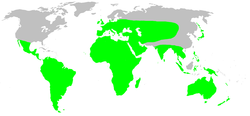| Ant spiders Temporal range: | |
|---|---|
 | |
| Female Mallinella fulvipes | |
 | |
| Caesetius sp. | |
| Scientific classification | |
| Kingdom: | Animalia |
| Phylum: | Arthropoda |
| Subphylum: | Chelicerata |
| Class: | Arachnida |
| Order: | Araneae |
| Suborder: | Opisthothelae |
| Infraorder: | Araneomorphae |
| Family: | Zodariidae Thorell, 1881 [1] |
| Diversity [2] | |
| 90 genera, > 1200 species | |
 | |
Ant spiders are members of the family Zodariidae. They are small to medium-sized eight-eyed spiders found in all tropical and subtropical regions of South America, Africa, Madagascar, Australia-New Guinea, New Zealand, Arabia, and the Indian subcontinent. [3]
Contents
Most species are daytime hunters and live together with ants, mimicking their behavior and sometimes even their chemical traits. [3] Although little is known about most zodariids, members of the genus Zodarion apparently feed only on ants; a number of other genera in the family are apparently also ant (or termite) specialists. [4]



